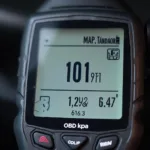Understanding your BMW’s OBD2 codes is crucial for effective diagnostics and repairs. Whether you’re a DIY enthusiast or a seasoned mechanic, this guide will provide you with a comprehensive list of BMW OBD2 codes, their meanings, and potential solutions.
Understanding OBD2 Codes in Your BMW
OBD2, or On-Board Diagnostics II, is a standardized system that allows you to access diagnostic information from your BMW’s computer. This information is presented as codes, which can pinpoint specific issues within the vehicle’s systems, from engine performance to emissions and transmission problems. Knowing how to interpret these codes can save you time and money on repairs.
Common BMW OBD2 Codes and Their Meanings
BMWs, like all vehicles, have a range of OBD2 codes specific to their systems. While generic OBD2 codes apply across makes and models, manufacturer-specific codes provide more detailed insights into BMW-specific problems. Let’s delve into some of the most frequently encountered BMW OBD2 codes:
- P0171 and P0174: These codes indicate a lean fuel mixture, meaning there’s too much air or not enough fuel entering the engine. This could be due to a faulty mass airflow sensor, oxygen sensor, or vacuum leak.
- P0300 – P0306: These represent misfires in specific cylinders. A misfire can be caused by faulty spark plugs, ignition coils, fuel injectors, or even low compression.
- P0420 and P0430: These codes suggest a problem with the catalytic converter efficiency. The catalytic converter is responsible for reducing harmful emissions, and these codes indicate it’s not functioning optimally. This could be due to a faulty oxygen sensor or a damaged catalytic converter.
How to Read BMW OBD2 Codes
Reading BMW OBD2 codes requires an OBD2 scanner, a device that plugs into your car’s OBD2 port, usually located under the dashboard. Once connected, the scanner can retrieve the stored codes from the vehicle’s computer. Many affordable and user-friendly scanners are available on the market, allowing DIYers to access this valuable diagnostic information.
- Step 1: Locate your BMW’s OBD2 port.
- Step 2: Plug in the OBD2 scanner.
- Step 3: Turn the ignition on (but don’t start the engine).
- Step 4: Follow the scanner’s instructions to retrieve the codes.
What to Do After Retrieving BMW OBD2 Codes
Once you have the list of BMW OBD2 Codes, the next step is to understand their meaning and potential causes. You can refer to resources like this guide, online forums, or repair manuals to pinpoint the source of the problem. Remember, while the codes provide a starting point, proper diagnosis may require further investigation and testing.
Advanced Diagnostics for BMW OBD2 Codes
For more complex issues, advanced diagnostic tools and software can provide deeper insights into your BMW’s systems. These tools allow access to live data streams, sensor readings, and other crucial information that can help pinpoint the root cause of a problem.
“Understanding the intricacies of BMW’s OBD2 system is essential for efficient and accurate diagnostics,” says John Miller, a seasoned automotive technician with over 20 years of experience specializing in BMWs. “Utilizing both generic and BMW-specific codes, along with advanced diagnostic tools, empowers mechanics to resolve issues effectively.”
Preventing Future BMW OBD2 Code Issues
Regular maintenance is key to preventing many OBD2 code issues. Following your BMW’s recommended service schedule, including regular oil changes, spark plug replacements, and other preventative measures, can help keep your car running smoothly and avoid costly repairs down the road.
List of BMW OBD2 Codes: Conclusion
Knowing how to interpret your BMW’s OBD2 codes is an invaluable skill for any car owner. This guide provides a starting point for understanding common BMW OBD2 codes and their meanings. Remember, proper diagnosis often requires further investigation, but by utilizing the information provided here, you can be better equipped to address your BMW’s needs.
FAQ
-
What is an OBD2 code? An OBD2 code is a trouble code stored in your vehicle’s computer that indicates a specific problem within a system.
-
Where can I find the OBD2 port in my BMW? The OBD2 port is usually located under the dashboard, on the driver’s side.
-
Do I need a special OBD2 scanner for my BMW? While any OBD2 scanner can read generic codes, a BMW-specific scanner might provide more detailed information.
-
What should I do if I can’t fix the problem indicated by the code? Consult a qualified BMW technician for further diagnosis and repair.
-
How can I prevent future OBD2 codes? Regular maintenance is the best way to prevent many OBD2 code issues.
“Regularly checking and addressing OBD2 codes is like giving your BMW a health checkup, ensuring it stays in top condition,” adds Maria Sanchez, a leading automotive engineer specializing in diagnostics. “Proactive maintenance and timely repairs can significantly extend the lifespan of your vehicle.”
Need support? Contact us via WhatsApp: +1(641)206-8880, Email: [email protected]. We have a 24/7 customer service team.

